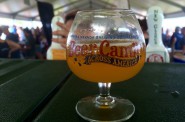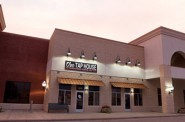The Beer Wizard of Water Street
George Bluvas rose from “broom pusher” to brewery master of Water Street Brewery. And he’s still learning.
Despite the seemingly endless number of breweries popping up throughout Southeastern Wisconsin, the brewing industry is one of the toughest to get into without a degree. Some of the best homebrewers are held back by an expensive piece of paper, but every once in a while dreams come true.
The current brewmaster at Milwaukee’s popular Water Street Brewery, George Bluvas, never attended college to become a brewer, unlike many of his competitors throughout the city. Instead, Bluvas began his career with Water Street Brewery in 1993 “pushing brooms and humping kegs,” while he pursued a fine arts degree at UW-Milwaukee. He had quite different plans back then.
“I was not planning on being a brewer. I was planning on doing full length animation,” says Bluvas with a chuckle. So how did the fine arts major end up a brewmaster?
Bluvas’ introduction to brewing wasn’t brewing at all. In fact, it was basic distillation in a high school science class. He then stepped into the world of brewing when a friend’s father taught him how to make hard cider at the age of 14. His early experiments with hard cider led to his first beer; an extract-based brown ale brewed in plastic buckets. The end result was a beer that tasted more like turpentine than beer. But every home brewer soon realizes their first few batches are destined for the sink, and Bluvas was undeterred. He kept at his hobby through his teenage years until he applied for a dishwashing job at the Water Street Brewery in 1993. Though the job had nothing to do with brewing, he negotiated a simple condition; he’d be the best dishwasher they’d ever seen if he could work in the brewery once in a while.
So Bluvas was brought onto the Water Street team as a dishwasher and brewery helper. His early work in the brewery focused primarily on washing kegs, pulling grain sacks, and occasionally adding hops to the kettles, all while learning from the brew master first hand. Six years later, after obtaining his Fine Arts degree, as well as another in Chemistry, he was tapped to take the helm of the brewery.
“If you go back to 18-year-old George and told him one day you’ll be running this brewery, I’d probably have laughed at you,” says Bluvas.
When he first took over as brewmaster, Water Street Brewery’s beer list was simple; European lager, amber, weiss, and Oktoberfest. Since taking over, Bluvas has expanded with a variety of interesting beers — from the trendy like the India Pale Ale and bourbon aged Märzen to completely original creations such as brown ale mixed with maple syrup and oatmeal, aged several months in brandy barrels. The last one, Bluvas explains, is more than just weird concoction, there’s a good deal of science involved.
According to Bluvas, after decades of drinking the same macrobrew adjunct every night, beer consumers in the United States grew bored and started developing new tastes. This boredom led to wider acceptance of skunky green bottle European imports in the 1980’s, but by the 1990’s people were beginning to wise up. Suddenly, Americans began to realize that skunky, sour, or other off flavors were not staples of European or craft beers; they were the result of light spoilage and brewers were forced to take better care to avoid these issues. Gradually, non-traditional flavors began to flourish as old world styles began to gain popularity in the American market. As such, the IPA has become the third most popular beer at Water Street, behind the Oktoberfest, and the all-time top seller, Honey Lager Light.
“As soon as I brew a batch it’s drank up and people are taking home growlers. I can’t even keep it in house,” says Bluvas of his old world styles. “Our whole culture of drinking has become, what’s next? I’m the kind of guy that goes to a bar and says what’s new? Bring it on!”
The last decade or so has seen an explosion in craft brews making available an unimaginable number of styles to the market for beer lovers of all tastes. So where do we go from here? Can the IPA be outdone in popularity among the Millennials? Bluvas thinks so.
“I consider myself more of a Belgian brewer than a German Brewer. The Germans are much more rigid,” he notes, hinting at the new direction he’s taking with his beer in 2015.
A world traveler, Bluvas has been to the Czech Republic and Belgium and has seen firsthand how they do beer there. Though he has Czech blood, from a country many know as the home of the pilsner, his heart is with Belgium and their family of styles that is just making it way to the States: sours.
While on a trip to Belgium, Bluvas witnessed a brewmaster literally spill his freshly fermented beer on the floor and then return it to the fermenter. While many would shudder at the thought of all of that bacteria infecting the beer, that was the point. While Belgium is known for its delightful wheat beers, it’s also known for its sour beers such as the Flanders Red Ale and Kriek, which are made by “infecting” traditionally brewed beers with bacteria. Fortunately, the sours made at Water Street Brewery are “infected” with a strain of Brettanomyces yeast, a yeast known for giving beer a mouth puckering sour flavor. In fact, Bluvas keeps a strict policy on sanitation and temperature control to ensure no beer goes bad before it sells out.
“It seems that the American taste is so geared toward salt and sugar that when you get something that’s not salty or sugary, it just freaks them out,” says Bluvas. “We’re not exactly a super-beer bar where you’d go for crazy beers. People come here for my Oktoberfest and my IPA. We’ll see if we’ll get some converts over to sour beers. Wisconsin is kind of behind as far as beer styles.”
It may be a long road for the sour beer before it reaches cult status like the IPA. In the meantime, Water Street Brewery will continue to push their sour beer options while focusing on more popular offerings like the Oktoberfest and Honey Lager Light. And by the way, if you want to get your hands on a Water Street brew, you need to go down to one of its three, soon to be four, locations, for the beer is only available in house, on draught.
“We’re still a small time brewery,” explains Bluvas, for the brewery only produces an average of 2,000 barrels a year. That’s miniscule compared to local microbreweries like Lakefront, which produces upward of 40.000 barrels a year, but as Bluvas puts it, “We like the fact that we brew the beer that you drink on premise. Basically, if you’re drinking at Water Street Brewery, you’re drinking beer made here.”
Fortunately for beer fans south of the city, a new, fourth location is presently under construction in Oak Creek. With this addition, Bluvas hopes to eclipse his current achievement of half a million barrels of beer produced all-time by hitting one million barrels before he retires. Though a lofty goal, its surely less daunting than his accomplishment in rising from dishwasher to brewmaster.
Beer City
-
The Crowd Rules At MobCraft Brewery
 Jul 7th, 2016 by Joey Grihalva
Jul 7th, 2016 by Joey Grihalva
-
Sierra Nevada Beer Camp Was a Winner
 Jun 13th, 2016 by Joey Grihalva
Jun 13th, 2016 by Joey Grihalva
-
The Rise of O’so Brewing Co.
 Dec 1st, 2015 by Christophor Rick
Dec 1st, 2015 by Christophor Rick
























This is a very good article about a very special person, my son. I think the article is one to post for young people to read when thinking about what to do after High School and if they do not want to go to college; it also is good to post it in trade schools or where ever visible for those still thinking, “What to do–what to do?????”